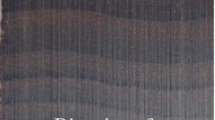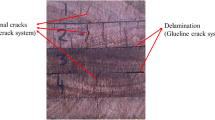Abstract
The mechanical properties of plantation-grown balsa wood from Papua New Guinea (PNG) were determined according to American Society for Testing and Materials D143-09. Static bending, hardness, compression parallel and perpendicular to grain, and shear parallel to grain tests were performed on kiln-dried specimens segregated into the three international density classes (80 ≤ 120, 120 ≤ 180 and 180 ≤ 220 kg/m3). The literature states balsa with a density between 120 and 180 kg/m3 has the most commercial value in contemporary markets. The results presented in this study indicate that balsa with a density around 150 kg/m3 can have superior strength properties to balsa with a higher and lower density (this was most evident in the compression perpendicular and shear tests). Specimen moisture content and air dry density were calculated to identify elements which may affect the strength properties of balsa. Generally, the greater the density of a specimen, the greater the strength. However, unusual patterns were noted in this study where density had little impact on the increase in strength (particularly in the hardness and shear tests). Average strength results for the medium density class of PNG-grown balsa were: modulus of elasticity 2037 MPa, modulus of rupture 16.6 MPa, hardness tangential surface 307 N, hardness radial surface 291 N, hardness axial surface 426 N, compression parallel 9.2 MPa, compression perpendicular 1.1 MPa and shear 1.9 MPa.
Similar content being viewed by others
References
American Society for Testing and Materials (2009) Standard test methods for small clear specimens of timber. D143. ASTM, West Conshohocken
Bootle K (1983) Wood in Australia. Types, properties and uses. McGraw-Hill Book Company, Sydney
Carrillo A, Garza M, Nañez M, Garza F, Foroughbakhch R, Sandoval S (2011) Physical and mechanical wood properties of 14 timber species from Northeast Mexico. Ann For Sci 68(4):675–679
Chowdhury M, Sarker S, Deb J, Sonet S (2013) Timber species grouping in Bangladesh: linking wood properties. Wood Sci Technol 47(4):797–813
Eddowes P (1977) Commercial timbers of Papua New Guinea; their properties and uses. Forest Industries Council of Papua New Guinea, Port Moresby
Eddowes P (2005) Solomon islands timber. Solomon Islands Forestry Management Project (SIFMP II). AusAID, Canberra
Francis J (1991) Ochroma pyramidale Cav. Balsa. Species Monograpg SO-ITF-SM-41. Institute of Tropical Forestry. United States Department of Agriculture Forest Service, Washington
Goodrich T, Nawaz N, Feih S, Lattimer B, Mouritz A (2010) High-temperature mechanical properties and thermal recovery of balsa wood. J Wood Sci 56(6):437–443
Kretschmann D (2010) Mechanical properties of wood. In: Ross R (ed) Wood handbook: wood as an engineering material. United States Department of Agriculture Forest Service, Madison
Midgley S, Blyth M, Howcroft N, Midgley D, Brown A (2010) Balsa: biology, production and economics in Papua New Guinea (report 73). ACIAR, Canberra
Osei-Antwi M, de Castro J, Vassilopoulos A, Keller T (2013) Shear mechanical characterization of balsa wood as core material of composite sandwich panels. Constr Build Mater 41:231–238
Shishkina O, Lomov S, Verpoest I, Gorbatikh L (2014) Structure–property relations for balsa wood as a function of density: modelling approach. Arch Appl Mech 84(6):789–805
Standards Australia (2000) Timber—methods of test—density. 1080.3. AS/NZS, Sydney
Standards Australia (2012) Timber—methods of test—moisture content. 1080.1. AS/NZS, Sydney
Tsoumis G (1991) Science and technology of wood structure, properties, utilization. Chapman and Hall, New York
Valle Tager G, Hartig J, Cabrero J, Haller P (2014) Selected mechanical properties of four Central American wood species. Eur J Wood Prod 72(5):699–702
Wiselius S (1998) Ochroma Sw. In: Sosef M, Hong L, Prawirohatmodjo S (eds) Plant resources of South-East Asia No 5(3). Timber trees: lesser-known timbers. Backhuys Publishers, Leiden
Acknowledgments
Special thanks to Kulala Mulung, Emily Flowers, Peter Kanowski and Braden Jenkin for organising Benson Gusamo’s trip and travel expenses to the University of Melbourne, Australia as a part of the Australian Centre for International Agricultural Research (ACIAR) balsa Project FST/2009/016. We are grateful to Allen Brittain for assistance in preparing balsa shear specimens at Swinburne University of Technology. Thanks to the balsa processors: The PNG Balsa Company Ltd and Coconut Products Limited in PNG for supplying the balsa for testing.
Author information
Authors and Affiliations
Corresponding author
Rights and permissions
About this article
Cite this article
Kotlarewski, N.J., Belleville, B., Gusamo, B.K. et al. Mechanical properties of Papua New Guinea balsa wood. Eur. J. Wood Prod. 74, 83–89 (2016). https://doi.org/10.1007/s00107-015-0983-0
Received:
Published:
Issue Date:
DOI: https://doi.org/10.1007/s00107-015-0983-0




